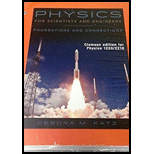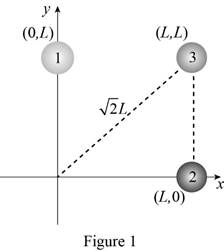
Concept explainers
The magnitude and the direction of the gravitational field at the origin due to the three particles.
Answer to Problem 33PQ
The magnitude of the gravitational field at the origin due to the three particles is
Explanation of Solution
Write the equation for the gravitational field at a point due to a particle.
Here,
The arrangement of the particles is shown in figure 1.

Refer to figure (I) and use equation (I) to find the field produced at the origin due to the particle 1.
Here,
Refer to figure (I) and use equation (I) to find the field produced at the origin due to the particle 2.
Here,
Use equation (I) to find the field produced at the origin due to the particle 3.
Here,
Find the distance between the particle 3 and origin.
Refer to figure 1 and write the expression for
Put the above two equations in equation (IV).
The gravitational field at the origin is the vector sum of the gravitational fields due to the three particles.
Here,
Put equations (II), (III) and (V) in the above equation.
Conclusion:
Multiply and divide equation (VI) by
Therefore, the magnitude of the gravitational field at the origin due to the three particles is
Want to see more full solutions like this?
Chapter 7 Solutions
Physics for Scientists and Engineers: Foundations and Connections
- Consider the Earth and the Moon as a two-particle system, a. How far from the center of the Earth is the gravitational field of this two-particle system zero? b. Sketch gravitational field vectors g along the line joining the Earth and the Moon. Indicate the point at which g=0 (Do not consider positions inside either object.)arrow_forward(a) What is the acceleration due to gravity on the surface of the Moon? (b) On the surface of Mars? The mass of Mars is SW 6.4181023kg and its radius is 3.38106m .arrow_forwardThree billiard balls, the two-ball, the four-ball, and the eight-ball, are arranged on a pool table as shown in Figure P7.26. Given the coordinate system shown and that the mass of each ball is 0.150 kg, determine the gravitational field at x=2m, y=0.arrow_forward
- Since March 2006, NASAs Mars Reconnaissance Orbiter (MRO) has been in a circular orbit at an altitude of 316 km around Mars (Fig. P6.81). The acceleration due to gravity on the surface of the planet Mars is 0.376g, and its radius is 3.40 103 km. Assume the acceleration due to gravity at the satellite is the same as on the planets surface. a. What is MROs orbital speed? B. What is the period of the spacecrafts orbit? FIGURE P6.81arrow_forward(a) Show that tidal force on a small object of mass m, defined as the difference in the gravitational force that would be exerted on m at a distance at the near and the far side of the object, due to the gravitational at a distance R from M, is given by Ftidal=2GMmR3r where r is the distance between the near and far side and rR .(b) Assume you are fallijng feet first into the black hole at the center of our galaxy. It has mass of 4 million solar masses. What would be the difference between the force at your head and your feet at the Schwarzschild radius (event horizon)? Assume your feet and head each have mass 5.0 kg and are 2.0 m apart. Would you survive passing through the event horizon?arrow_forward(a) Compute the vector gravitational field at a point P on the perpendicular bisector of the line joining two objects of equal mass separated by a distance 2a as shown in Figure P11.12. (b) Explain physically why the field should approach zero as r 0. (c) Prove mathematically that the answer to part (a) behaves in this way. (d) Explain physically why the magnitude of the field should approach 2GM/r2 as r . (e) Prove mathematically that the answer to part (a) behaves correctly in this limit. Figure P11.12arrow_forward
- (a) In order to keep a small satellite from drifting into a nearby asteroid, it is placed in orbit with a period of 3.02 hours and radius of 2.0 km. What is the mass of the asteroid? (b) Does this mass seem reasonable for the size of the orbit?arrow_forward(a) How far from the center of Earth would the net gravitational force of Earth and the Moon on an object be zero? (b) Setting the magnitudes of the forces equal should result in two answers from the quadratic. Do you understand why there are two positions, but only one where the net force is zero?arrow_forward(a) Calculate the acceleration due to gravity on the surface of the Sun. (b) By what factor would your weight increase if you could stand on the Sun? (Never mind that you cannot.)arrow_forward
- (a) Suppose that your measured weight at the equator is one-half your measured weight at the pole on a planet whose mass and diameter are equal to those of Earth. What is the rotational period of the planet? (b) Would you need to take the shape of this planet into account?arrow_forwardConsider the Earth and the Moon as a two-particle system. a. Find an expression for the gravitational field g of this two-particle system as a function of the distance r from the center of the Earth. (Do not worry about points inside either the Earth or the Moon.) b. Plot the scalar component of g as a function of distance from the center of the Earth.arrow_forward(a) Using the data in the previous problem for the asteroid Vesta which has a diameter of 520 km and mass of 2.671020kg , what would be the orbital period for a space probe in a circular orbit of 10.0 km from its surface? (b) Why is this calculation marginally useful at best?arrow_forward
 Physics for Scientists and Engineers: Foundations...PhysicsISBN:9781133939146Author:Katz, Debora M.Publisher:Cengage Learning
Physics for Scientists and Engineers: Foundations...PhysicsISBN:9781133939146Author:Katz, Debora M.Publisher:Cengage Learning University Physics Volume 1PhysicsISBN:9781938168277Author:William Moebs, Samuel J. Ling, Jeff SannyPublisher:OpenStax - Rice University
University Physics Volume 1PhysicsISBN:9781938168277Author:William Moebs, Samuel J. Ling, Jeff SannyPublisher:OpenStax - Rice University Principles of Physics: A Calculus-Based TextPhysicsISBN:9781133104261Author:Raymond A. Serway, John W. JewettPublisher:Cengage Learning
Principles of Physics: A Calculus-Based TextPhysicsISBN:9781133104261Author:Raymond A. Serway, John W. JewettPublisher:Cengage Learning Physics for Scientists and Engineers, Technology ...PhysicsISBN:9781305116399Author:Raymond A. Serway, John W. JewettPublisher:Cengage Learning
Physics for Scientists and Engineers, Technology ...PhysicsISBN:9781305116399Author:Raymond A. Serway, John W. JewettPublisher:Cengage Learning College PhysicsPhysicsISBN:9781938168000Author:Paul Peter Urone, Roger HinrichsPublisher:OpenStax College
College PhysicsPhysicsISBN:9781938168000Author:Paul Peter Urone, Roger HinrichsPublisher:OpenStax College




